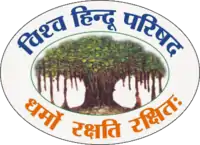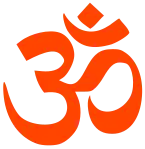Vishva Hindu Parishad
The Vishva Hindu Parishad (VHP) (transl. Universal Hindu Council) is an Indian right-wing Hindu organisation based on Hindu nationalism.[3]
 Logo of the V.H.P | |
| Abbreviation | VHP |
|---|---|
| Motto | Dharmo Rakṣati Rakṣitaḥ |
| Formation | 29 August 1964[1] |
| Founder | |
| Type | Right-wing |
| Purpose | Hindu nationalism and Hindutva |
| Headquarters | New Delhi, India |
| Coordinates | 28.33°N 77.10°E |
Region served | India |
Membership | 6.8 million[2] |
Official language | Hindi |
International President | Vishnu Sadashiv Kokje |
| Subsidiaries |
|
| Affiliations | Sangh Parivar |
| Website | vhp |
The VHP was founded in 1964 by M. S. Golwalkar and S. S. Apte in collaboration with Swami Chinmayananda. Its stated its objective is "to organise, consolidate the Hindu society and to serve and protect the Hindu Dharma".[1]
The VHP is considered as a member of the Sangh Parivar group,[4][5] an umbrella of Hindu nationalist organisations led by the RSS. It has been involved in construction and renovation of Hindu temples, issues of cow slaughter, religious conversion, the Ayodhya dispute and its role in the Babri Masjid demolition.[6][7] In 2018 the CIA classified the VHP as a militant religious organisation.[8][9]
History
The VHP was founded in 1964 by RSS leaders M. S. Golwalkar and S. S. Apte in collaboration with the Hindu spiritual leader Chinmayananda.[10][11] The delegation of the founders included Bharatiya Vidya Bhavan founder K. M. Munshi, Gujarati scholar Keshavram Kashiram Shastri, Sikh leader Master Tara Singh, Namdhari Sikh leader Satguru Jagjit Singh and eminent politicians such as Sir C. P. Ramaswamy Iyer.[12][13]
Chinmayananda was nominated as its founding President, while Apte was nominated as its founding General Secretary. It was decided at the meeting that the name of the proposed organisation would be "Vishva Hindu Parishad" and that a world convention of Hindus was to be held at Prayag (Allahabad) during Kumbha Mela of 1966 for its launch. It was further decided that it would be a non-political organisation and that no office bearer of any political party shall be simultaneously an office bearer in the Parishad.[13]
In the mid 1990s, VHP had 1.6 million members worldwide.[14] According to a 2008 estimate, VHP claimed 6.8 million members.[2]
Ideology
The VHP, which considers Buddhists, Jains and Sikhs as well as native tribal religions as part of the greater Hindu fraternity, officially mentions that it was founded by the "Saint Shakti of Bharat". The VHP was first mooted at a conference in Pawai, Sandipani Sadhanalaya, Bombay on 29 August 1964. The conference was hosted by RSS chief M. S. Golwalkar. The date was chosen to coincide with the festival of Janmashtami. Several representatives from the Hindu, Sikh, Buddhist and Jain faiths were present in the meeting, as well as the Dalai Lama.[15] Golwalkar explained that "all faiths of Indian origins need to unite", saying that the word "Hindu" (people of "Hindustan") applied to adherents of all the above religions.[16] Apte declared:
The world has been divided to Christian, Islam and communist. All of them view Hindu society as very fine rich food on which to feast and fatten themselves. It is necessary in this age of conflict to think of and organise the Hindu world to save it from the evils of all the three.[16]
Its main objective is "to organise, consolidate the Hindu society and to serve, protect the Hindu Dharma".[1] It has been involved in social service projects and in encouraging the construction and renovation of Hindu temples. It is against the caste system, and opposes cow slaughter and conversions to other religions. Defending Hindus around the world and Hindu rights has been one of its stated objectives.[17] The other main objective which it has been involved with is the Ayodhya dispute.[1]
On 4 June 2018, CIA classified VHP and Bajrang Dal as religious militant organizations under the category of political pressure groups.[18][19]
The organisation acts under the guidance from Dharma Sansad, a religious parliament of Gurus.[12] The VHP is associated with the Sangh Parivar, an umbrella of Hindu nationalist organisations. Its slogan is Dharmo rakṣati rakṣitaḥ, which means "Dharma protects its protector" and its symbol is the Banyan tree. The current international president of VHP is Vishnu Sadashiv Kokje, while its international working president is Alok Kumar Advocate.
Social services
Vishva Hindu Parishad is active in social welfare work:[20][21]
- Medical training – People are trained in villages to provide primary health care and referral services. The organisation also conducts medical check-up camps.[21]
- Vocational training – Organisation is running self-employment training camps in Bihar, Punjab, Rajasthan, Maha Kaushal, Assam, Brij Pradesh, Odisha and Maharashtra. The training areas involve farming techniques, bee-keeping, agriculture, horticultural techniques, animal husbandry and sewing.[22] There are 959 training centres currently operating.[21]
- Education – It tried to provide educational facilities in remote area. It supports 3266 educational facilities.[21]
- Social welfare – The organisation runs 45 orphanages, marriage bureaux, help centres, rescue centres, temples, hostels[23] and working women's hostels. VHP is also active in environmental causes such as tree plantations. Social services are provided in religious pilgrimages, emergency help during natural calamities and rural development.[21][24]
- Relief services – Vishwa Hindu Parishad has provided emergency relief services. In the 2014 Jammu and Kashmir floods, Vishwa Hindu Parishad organised medical and relief camps. These services provided relief via medical camps to 1400 patients.[25][26]
Youth organisations

The Bajrang Dal founded in 1984, is organised in many states in major training camps called shakhas, where thousands of youths simultaneously train in various activities, receive sports, education in Hindutva and cultural indoctrination. The Durga Vahini, founded in 1991 under the tutelage of Sadhvi Rithambara as its founding chairperson and the support of the VHP, is described as the "female arm of the Dal". Members of the Vahini contend that the portrayal of their group as a branch of the Bajrang Dal is an oversimplification, and that their goals are to "dedicate ourselves to spiritual, physical, mental and knowledge development".[27] The VHP also have divisions made up of women. VHP secretary Giri Raj Kishore charted out highly visible roles for women in the group. He charted out two "satyagrahas" for women during their demonstrations.[28]
The VHP has been a prime backer of the World Hindu Conference in which issues such as casteism, sectarianism, and the future of Hindus were discussed. Prior Conferences have included Hindu Groups such as Parisada Hindu Dharma.[29]
International presence
Vishwa Hindu Parishad has presence in 29 countries outside of India.[30] The Australia wing of Vishva Hindu Parishad conducts activities such as conducting weekend schools, language classes, cultural workshops, festivals. The festivals are also organised for open to all communities promoting Unity in Diversity.[31] The press release from city council of Holroyd states that Vishva Hindu Parishad is active in supporting multiculturalism in the same region.[32]

Hindu Students Council (also known as HSC) is an organization of Hindu students in the United States of America and Canada. The HSC was set up in 1990 with support from the Vishwa Hindu Parishad of America;[33] its current association with that body is a matter of some debate,[34] though it says that it became fully independent in 2003.[35] Prior to its separation from its parent organization, it was considered to be the student-wing of the VHP.[36][37][38][39] In 2011, Hindu Students Council was awarded a Readers' Choice Award for Best Hindu Organization in an online vote held by About.com.[40]
Other activities
VHP organises programmes to promote return or reconversion of Hindus who were previously converted to Christianity or Islam through their trained missionaries called Dharma Prasaar Vibhag (Dharma Propagation Unit), some of them were sent to remote villages and tribal areas which have substantial Christians and Muslims population.
From 1982 to 1985, over 66,000 people were reconverted to Hinduism following the efforts of VHP.[41]
The VHP had been aggressively involved in the Ayodhya dispute over the Ram Janmabhoomi, or Babri Mosque before its demolition, since March 1984, after getting encouraged by the strong response it had got from ekatmata yatra programme, it organised in 1983, which was aimed at Hindu unity and self-protection against Islam and Christianity. This activity in the Ayodhya issue involved demonstrations, petitions and litigation, along with militant processions, forceful conversion ceremonies and incidents of violence and vandalism, particularly targeting Muslims.[42] The VHP is also said to have sought the destruction of the Babri mosque. According to the VHP and its affiliated organisations, the Babri Mosque was built by demolishing the temple at the birthplace of Rama (Ram Janmabhoomi) by the Mughal Emperor Babur in the 16th century. It further stated in Allahabad court documentation that the building was in a dilapidated condition. It was in ruins and could not be used for worship or any activities.[43][44][45][46]
In Punjab, the VHP has played an active role to prevent conversions of Sikhs. Majority of them are low caste Sikhs converting to Christianity. This may be a result of oppression by high caste Sikhs but there are considerable free will conversions among the higher class Sikhs too; however, the VHP have forcibly stopped Christian missionaries from converting Sikhs.[47]
According to the Human Rights Watch, VHP and Bajrang Dal had been involved in 2002 Gujarat riots.[48] Though VHP has denied these claims, VHP spokesman Kaushikbahi Mehta said, "We in the VHP had nothing to do with the violence except to take care of widows and victims of the Godhra mayhem."[49]
VHP engaged in "re-conversion" program in the state of Orissa. In June 2002, VHP converted 143 tribal Christians into Hinduism in Tainser village of Sundergarh district.[50] In 2005, VHP in Bargarh carried out reconversion ceremony for 567 Christians. The new converts had signed affidavits, confirming their intention to change their religion. Another 600 Dalit tribal Christians were converted to Hinduism in Bijepur, Orissa.[51]
In April 2005, in West Bengal members of 45 tribal families converted to Hinduism from Christianity in a ceremony organised by Akhil Bhartiya Sanatan Santhal, allied to VHP.[51]
VHP claimed to have converted 5,000 people to Hinduism in 2002.[50] In 2004, VHP claimed to have converted 12,857 people to Hinduism. 3,727 of these were Muslims and 9,130 were Christians.[52]
In 2005, after the protests organised by VHP, the Jharkhand Assembly passed a Cow Protection Commission Bill that made the killing of, cruelty to and illegal trading of cows a crime.[53]
In 2007, VHP had launched nationwide protest against demolition of the Rama Setu.[54] On 12 September 2007, the VHP, with the aid of BJP and the Rameswaram Sreeramsetu Surakshaya Manch, had blocked road and rail traffic in Orissa. Thousands of activists participated in these protests in Bhubaneswar, Jatani, Rourkela, and Sambalpur.[55][56]
In 2015, VHP defended the demolition of a church in Haryana, although it has denied involvement in the incident. VHP joint general secretary Surendra Jain alleged that the church was built "for the purpose of aggressive conversion" and likened its destruction to the violence of the 1857 war which he claimed "was fought for the cause of religion".[57]
References
- "VHP main objective". Vhp.org. 29 August 1964. Retrieved 24 August 2014.
- "New Delhi left grasping for answers to violence". The National. 13 October 2008.
- Jaffrelot, Christophe (31 December 2008). "Hindu Nationalism and the (Not So Easy) Art of Being Outraged: The Ram Setu Controversy". South Asia Multidisciplinary Academic Journal (2). doi:10.4000/samaj.1372. ISSN 1960-6060.
- Jelen, Ted Gerard; Wilcox, Clyde (2002). Religion and Politics in Comparative Perspective: The One, The Few, and The Many. Cambridge University Press. p. 253. ISBN 978-0-521-65031-1.
- DP Bhattacharya, ET Bureau (4 August 2014). "Communal skirmishes rising after Narendra Modi's departure from Gujarat - Economic Times". Articles.economictimes.indiatimes.com. Retrieved 14 August 2014.
- Thomas Blom Hansen (1999). The Saffron Wave: Democracy and Hindu Nationalism in Modern India. Princeton University Press. ISBN 978-0195645743.
- "VHP's social service activities". The Hindu. 18 December 2011. Retrieved 24 August 2014.
- "CIA classifies VHP, Bajrang Dal as millitant religious outfits". India Today. Ist. Retrieved 13 October 2019.
- "POLITICAL PRESSURE GROUPS AND LEADERS". www.cia.gov.
- Katju 2013, p. 5.
- Kurien, Prema (2001). "Religion, ethnicity and politics: Hindu and Muslim Indian immigrants in the United States". Ethnic and Racial Studies. 24 (2): 268. doi:10.1080/01419870020023445. S2CID 32217209.
- Katju 2013.
- "Inception of VHP". vhp.org. Retrieved 24 August 2014.
- J. Gordon Melton; Martin Baumann (21 September 2010). Religions of the World: A Comprehensive Encyclopedia of Beliefs and Practices, 2nd Edition [6 volumes]: A Comprehensive Encyclopedia of Beliefs and Practices. ABC-CLIO. ISBN 9781598842043.
- Long, Jeffery D. (2011). Historical dictionary of Hinduism (New ed.). Lanham, Md.: Scarecrow Press. p. 319. ISBN 978-0-8108-6764-2.
- Smith 2003, p. 189.
- "Welcome to Organiser". Organiser.org. Retrieved 14 August 2014.
- "VHP a militant religious outfit, RSS nationalist: CIA factbook". The Times of India.
- "CIA calls VHP, Bajrang Dal 'religious militant organisations'".
- Hansen, Thomas Blom (23 March 1999). The Saffron Wave: Democracy and Hindu Nationalism in Modern India - Thomas Blom Hansen - Google Books. ISBN 978-1400823055. Retrieved 14 August 2014.
- "विश्व हिंदू परिषदेची पन्नास वर्षांची वाटचाल | Evivek.com". Magazine.evivek.com. Archived from the original on 14 August 2014.
- "VHP to highlight its social work". The Times of India. 19 December 2003. Retrieved 14 August 2014.
- E. Toffolo, Chris (2012). Emancipating Cultural Pluralism. SUNY Press. p. 166. ISBN 9780791487495.
- Menon, Kalyani Devaki (6 July 2011). Everyday Nationalism: Women of the Hindu Right in India – Kalyani Devaki Menon. ISBN 978-0812202793. Retrieved 14 August 2014.
- "Jammu and Kashmir floods: Vishwa Hindu Parishad organises medical camps, 1,400 patients treated". dna. 15 September 2014.
- "VHP organises medical camps in Jammu, 1,400 patients treated". The Economic Times.
- Women 'Ram Bhakt' hog limelight,The Tribune
- Kohli, Atul (2000). The Success of India's Democracy. Cambridge University Press. p. 174. ISBN 978-0-521-80144-7.
- "Historic world Hindu conference at Prayag". News Today. March 2007. Archived from the original on 18 March 2009.
- "विदेश में हिन्दू – Hindus abroad – Vhp". Retrieved 7 April 2020.
- "Community Directory". Multicultural.vic.gov.au. 23 March 2014. Retrieved 24 August 2014.
- "Hindu heritage inspires multiculturalism in Holroyd | Holroyd City Council". Holroyd.nsw.gov.au. 13 February 2014. Retrieved 24 August 2014.
- Kaur, Raminder (2003). Performative Politics And The Cultures Of Hinduism: Public Uses of Religion in Western India. London: Permanent Black.
- Roof, Wade Clark. Contemporary American Religion. Macmillan. p. 305.
- "Live Casino Terpercaya | Situs Judi | Taruhan bola Online". v88judi.club (in Indonesian). Retrieved 18 November 2020.
- Rajagopal, Arvind (2001). Politics After Television: Religious Nationalism and the Reshaping of the Indian Public. Cambridge University Press. p. 257.
- 2003 Yearbook, the Centre for the Study of Global Governance, London School of Economics
- "The Struggle for India's Soul", Mira Kamdar, World Policy Journal.
- "Negotiating Hindu Identities in America", by Diana Eck, in The South Asian Religious Diaspora in Britain, Canada, and the United States Raymond Brady Williams, Harold G. Coward, John Russell Hinnells eds., State University of New York Press, 2001, p.234.
- "East Asia History".
- Parvathy, A.A. (2003). Lost Years of the RSS. Deep and Deep Publications. p. 127. ISBN 9788176294508.
- Katju, Manjari (2003). Vishva Hindu Parishad and Indian Politics. Orient Blackswan. pp. 8, 113. ISBN 9788125024767.
- Katju, Manjari (2003). Vishva Hindu Parishad and Indian Politics. Orient Blackswan. pp. 45, 67. ISBN 9788125024767.
- Russell, Malcolm (1 August 2012). Middle East and South Asia 2012. Rowman & Littlefield. p. 231. ISBN 9781610488891.
- "Ayodhya files, Vol. 7" (PDF). Allahabad High Court. Retrieved 24 August 2014.
- Vinod Mishra (December 1992). "On Communalism". Marxists.org. Retrieved 24 August 2014.
- Rana, Yudhvir (31 March 2005). "VHP against conversions in Punjab". The Times Of India.
- "WE HAVE NO ORDERS TO SAVE YOU". www.hrw.org. Retrieved 24 May 2017.
- "Eves as Ram bhakts, the Gujarat model - Times of India".
- Faith Under Fire. Anamika Pub & Distributors. 2008. p. 370. ISBN 9788174953209.
- Praveen Kumar Chaudhary (2011). Communal Crimes and National Integration: A Socio-legal Study. Readworthy. p. 100. ISBN 9789350180402.
- Basu, Amrita (2015). Violent Conjunctures in Democratic India. Cambridge University Press. p. 47. ISBN 9781107089631.
- Atul Kohli; Prerna Singh (2013). Routledge Handbook of Indian Politics. Routledge. ISBN 9781135122744.
- Arvind Sharma; Madhu Khanna (2013). Asian Perspectives on the World's Religions after September 11. ABC-CLIO. p. 207. ISBN 9780313378973.
- Chatterji, Angana P. (1 March 2009). Violent gods: Hindu nationalism in India's present : narratives from Orissa. Three Essays Collective.
- "Ram Setu: VHP rail and road blockade in Orissa on Sept 12". Zee News. 8 September 2008.
- "VHP defends attack on Haryana church, calls 1857 'communal war'". Times of India. Retrieved 17 March 2015.
Bibliography
- Clarke, Peter (2004). Encyclopedia of New Religious Movements. Routledge. ISBN 978-0-203-48433-3.
- Jaffrelot, Christophe (2011). Religion, Caste, and Politics in India. C Hurst & Co. ISBN 978-1849041386.
- Juergensmeyer, Mark (1993). The New Cold War? Religious Nationalism Confronts the Secular State. University of California Press. ISBN 978-0-520-08651-7.
- Katju, Manjari (2013). Vishva Hindu Parishad and Indian Politics. Orient Blackswan. ISBN 978-81-250-2476-7.
- Kumar, Praveen (2011). Communal Crimes and National Integration: A Socio-Legal Study. Readworthy Publications. ISBN 978-93-5018-040-2.
- Smith, David James (2003). Hinduism and Modernity. Blackwell Publishing. ISBN 978-0-631-20862-4.
External links
| Part of a series on |
| Hinduism |
|---|
 |
|